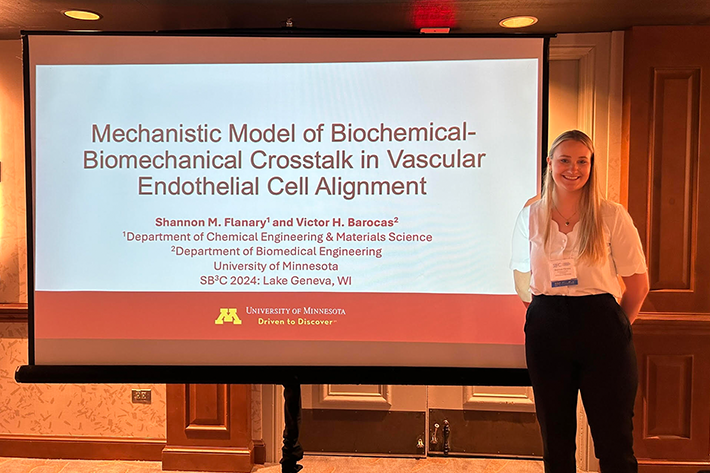Shannon Flanary wins first place at the ASME Student Paper Competition

Shannon Flanary, a CEMS Ph.D. candidate advised by Dr. Victor Barocas won first place in the American Society of Mechanical Engineers (ASME) Summer Biomechanics, Bioengineering, and Biotransport Conference (SB3C) Ph.D. Student Paper Competition. Flanary's paper was selected as the winner from over 165 competing submissions.
Shannon Flanary attended the 2024 SB3C Meeting in Lake Geneva, WI, and presented her oral presentation. A team of anonymous judges selected Flanary’s presentation titled, “Mechanistic model of biochemical-biomechanical crosstalk in vascular endothelial cell alignment” as the winner of the Biotransport, Human Motion, Reproductive, and Other Emerging Topics section.
Congratulations, Shannon Flanary! For more information about the award and SB3C, visit their website.
Summary of Shannon Flanary’s research: Blood vessels experience dynamic and complex loads from several directions, and these mechanical stimuli are vital for proper cellular and extracellular matrix organization and function. Endothelial cells (ECs) are the predominant cell type within the inner layer of blood vessels. As has been demonstrated in decades of in vitro work, ECs alter their geometric phenotype due to the applied loading conditions; ECs align parallel with shear stress and perpendicular to cyclic, uniaxial stretch. An aligned and elongated geometric phenotype also confers changes in the biochemical performance of the cells, especially in processes important for blood pressure regulation and the repression of atherosclerotic plaque formation. Interestingly, in high glucose environments, ECs have a blunted alignment response to shear stress in vitro, and hyperglycemic blood vessels have widespread endothelial dysfunction in vivo. To investigate the mechanisms behind biochemical and biomechanical crosstalk in EC alignment, a computational model was constructed that integrated biochemical signaling, stress fiber contraction, and cell-substrate mechanical feedback. The model recapitulates both the healthy and hyperglycemic EC response to shear stress, and the model has the capacity to also evaluate EC responses to cyclic or static stretch as well as variations in substrate stiffness. In addition to recapitulating previous findings, the model can also tease out potential mechanisms by decoupling biochemical and biomechanical components in experimentally unfeasible combinations. This work demonstrates the importance of integrating biochemical and biomechanical stimuli for understanding EC function.